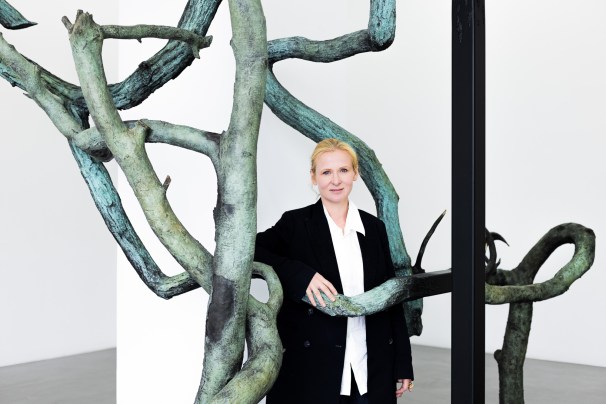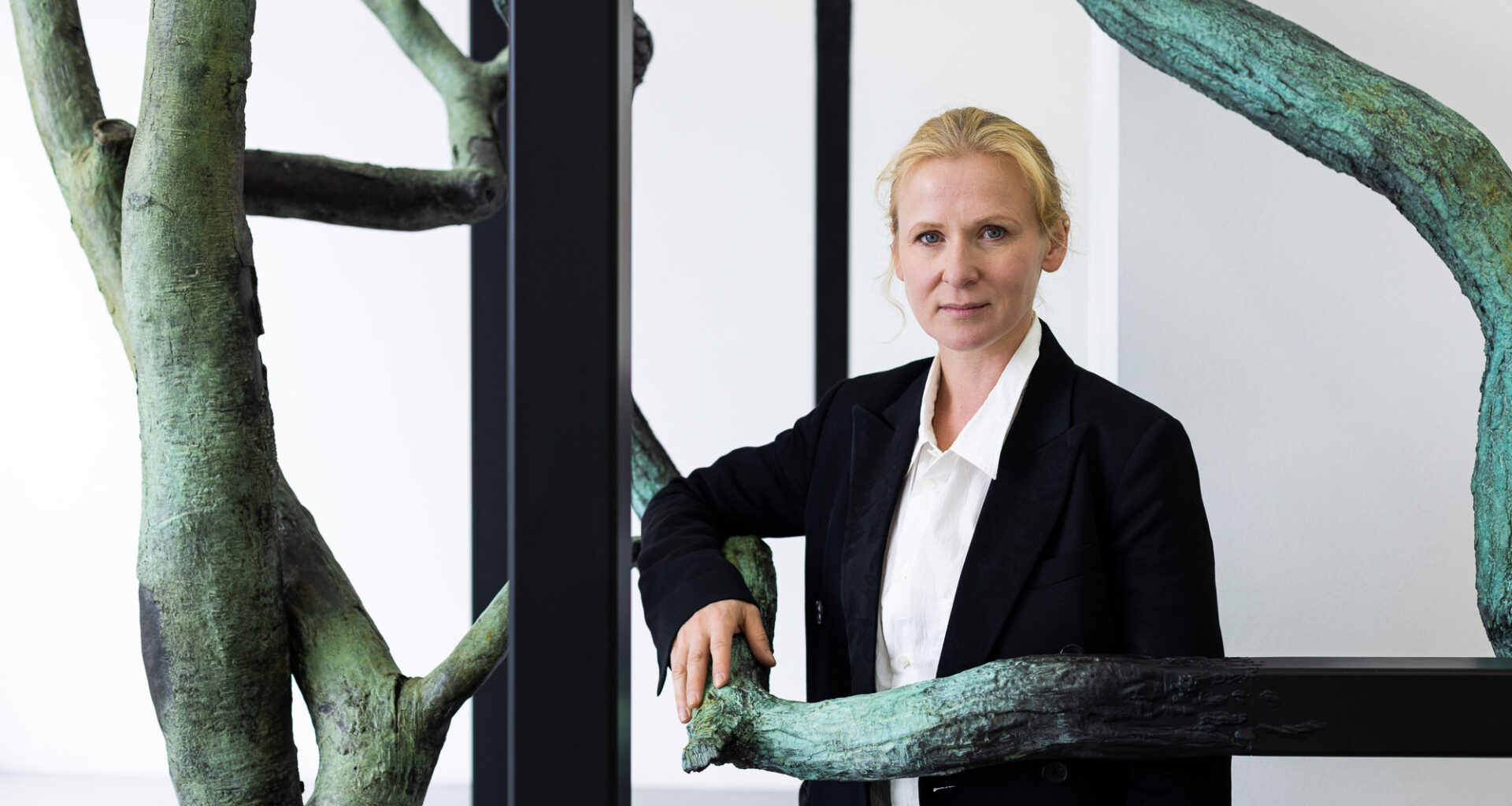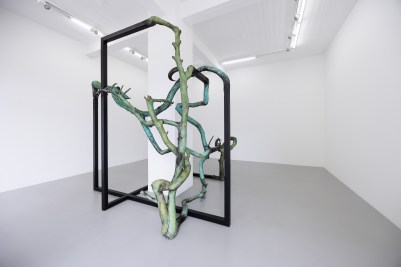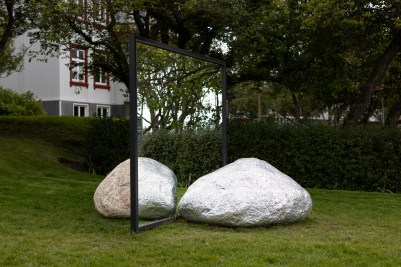On a warm Thursday night, one corner of Tryggvagata is alive with chatter. Art students, collectors, museum professionals and at least one wayward classics professor have gathered outside i8 Gallery, along with a surprising number of art-sniffing dogs. The free drinks are certainly appreciated — this is Iceland, after all — but the real draw is Silent Archibionts, a new solo show by acclaimed artist Alicja Kwade.
From the street, peering through the gallery window, you can spot a strange, large-scale sculpture wrapped around the gallery’s white column. Its steel beams organically evolve into mossy green branches, deer antlers and ram horns. Archibiont is just one of the few works the Polish-German multidisciplinary artist brings to town.
What’s real, anyway?
Known internationally for her large-scale public installations and sculptures exhibited from Venice Biennale to the Met, film, photography, and works on paper — Alicja Kwade’s long been fascinated by the slow unravelling of reality. Born in communist Poland, Alicja grew up in Germany, and started her career in Berlin. Often referring to magician Houdini as one of her “heroes,” Alicja has built her practice on deconstructing our original perceptions. From her early works — where she spotted her doppelgänger in a magazine, recreated the same photoshoot, and placed the two photos side by side, as if they were looking at each other, her work often revolves around the fundamental structures of time, space, and matter, and the question she returns to again and again: what do we even mean when we say something is real?
“The world is a very funny place, because we function because of very abstract agreements,” she says when we speak before the exhibition opening. “Because we agree on certain things. We believe we have a certain reality.”
She’s skeptical about the supposed solidity of that reality. “Why do we call this a tree, and that a table, even if they are the same?” she asks, gesturing across the room. “I’m trying to very deeply look into objects and what they are.”
Speaking fast and to the point, Alicja’s never tired of asking questions.
“To examine the question of a tree, for example — what does it mean to be a tree? I’m also trying to understand where human-made objects and natural events overlap.”
Alicja made up the name “Archibiont” for the exhibition title and the sculpture itself by combining the words “architecture” and “beings.” “I kind of like how it looks and how it’s spelled out because it reminds me of Greek mythology — it’s like a creature,” she explains.
In Archibiont, Alicja draws heavily on philosophy, particularly Aristotle’s concept of hylomorphism, which looks at how material and form combine to create living beings. “Aristotle came in the game because he was actually the first one to ask those questions,” she explains. “He was the first one who was trying to figure out what nature is, what human influence on nature is, and also what art is.”
“The world is a very funny place, because we function because of very abstract agreements.”
Three elements co-exist in the piece: the man-made world, represented by gritty stainless steel bars coated in black powder; tree branches, probably one of the first materials humans used to construct buildings; and deer antlers and ram horns, which represent, what Alicja calls “cultivated nature” — the kind of nature humans shape to serve their needs.
Alicja stresses that she wanted to exhibit this piece on its own in Iceland. “I thought it’s perfect for Iceland because you don’t have any trees here. You killed them all,” she says with a smile, adding that Archibiont explores the questions that are very much in the room. “What is human-made nature? How are we shaping that? What does it mean?” she pauses and adds,
“This is very much Iceland — a beautiful, incredible piece of nature, but very much shaped and made by humans, also.”


High-tech art
Following in the footsteps of celebrated artists like Andy Warhol and Mario Testino, Alicja has reached a stage in her career where she prefers to direct her work rather than craft every centimetre of it by hand. “When I was young, of course, I learned how to weld. I learned how to do stonework and stuff,” she says. “On this scale, it’s impossible. Why should I? It’s not very effective. I’m not as good as somebody who’s professionally trained in doing that.” It’s also a question of what an artist can or cannot afford, she explains.
“When I was a student, I could barely afford to buy myself a ticket for public transportation. So I couldn’t, for sure, afford 3D scans and stuff like this.” Now, with the support of a large team and advancement in computer modelling, Alicja spends much of her time on research, concept development, and engineering the final works. “There’s a lot of computer work. Even if it does not look like it, it’s very, very high-tech,” she smiles.
When working on Archibiont, for example, Alicja’s team contacted a company responsible for cutting down trees around Berlin. They picked up the discarded branches, scanned them, and created a catalogue — each branch assigned a number and a colour — before printing them in 3D. The parts were initially produced at a 1:20 scale, allowing Alicja to experiment with assembling the sculpture as a model. Once she was satisfied with the smaller version, the team set to work building the full-scale piece.
Everything is agreed upon
Even though the exhibition centres on a single large-scale work, there’s one more piece by Alicja on display at the gallery. Titled Selbstporträt, the artwork features 24 capsules containing elements found in the human body — oxygen, carbon, hydrogen, nitrogen, calcium, to name a few — arranged in a formation that resembles a clock, a target, or a portrait distilled to its elemental form. “The human body is made of 24 chemical elements, which is not much,” says Alicja. “You just need 24 things to cook a human being.”
“Sometimes I wish people would look behind things a little bit. Because there is no such thing as the truth.”
A ten-minute walk from i8 Gallery, another work by Alicja is currently on view. On loan from i8 to the National Gallery of Iceland, Big Be-Hide — made from “being and hiding” — is an older concept where Alicja explores the same philosophical questions by challenging and reshaping how we perceive reality, this time in a public space. “I thought that public art is very important to do because it is very influential — it can really do a change. That’s why, in my practice, I focused on bigger outdoor sculptures,” she reflects.
The piece consists of two rocks: one natural, the other its metallic counterpart, divided by a two-sided mirror. “What the mirror is doing is more like creating a frame, or a gate, or something. When you walk around it, it seems like things are appearing, disappearing, melting into each other,” Alicja explains. “But it’s also asking the same question: What is this piece of nature? Is this stone more stone than the other stone? Is this aluminium stone already art, even if it is just a copy of nature? Is it art because they say so? Or is it more about my point of view and what I learned about nature or environment?”
When asked if she expects viewers to walk away asking the same kinds of questions, Alicja laughs, “Of course, I would love them to get out and be very uncertain about themselves.”
“I’m never trying to give a message. I don’t have a message. There’s no message. But sometimes I wish people would look behind things a little bit. Because there is no such thing as the truth. There’s no correct way. There’s not a political system or given fact. It’s your decision each day. It’s your decision to pay three euros for a coffee [Editor’s note: I don’t know where she’s paying three euro for a coffee, but it’s not in Iceland]. It’s your decision to believe that those people are better than those people — or the other way. We do it every day. My big hope would be to open an awareness of that — that things are there not because they’re given,” she says. “They are there because we all agreed to call this thing a glass even if it is a tea set.”
Silent Archibionts by Alicja Kwade is on view at i8 Gallery on Tryggvagata 16 until September 6. Big Be-Hide is on display in the sculpture garden next to the National Gallery of Iceland until May 1, 2026.


